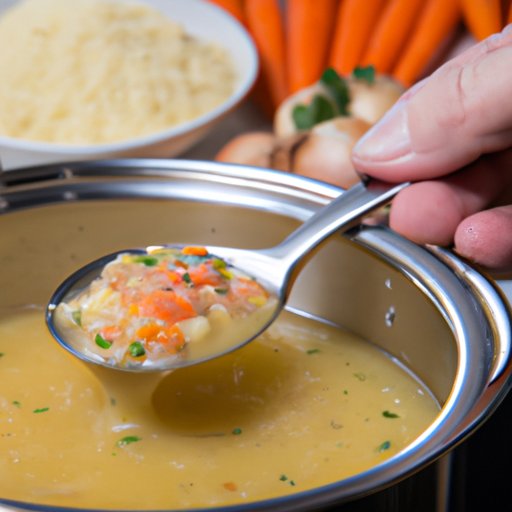I. Introduction
Gravy is an essential part of many dishes and can make all the difference to a meal. Whether you’re hosting a dinner party or cooking up a weeknight dinner, a flavorful gravy elevates any meal. However, making gravy from scratch can be daunting, especially if you’re not familiar with the process.
In this article, we’ll take you through everything you need to know to master the art of gravy making, from the basic steps to advanced techniques. We’ll share tips and tricks, foolproof recipes, and common mistakes to avoid, so you’ll never be stuck with lumpy or bland gravy again.
II. Mastering the Art of Gravy: A Step-by-Step Guide to Make Perfect Gravy Every Time
Making gravy from scratch may seem like a daunting task, but it’s actually quite simple once you know the basic steps. Here’s a step-by-step guide to making perfect gravy every time:
1. Start with a roux: A roux is a combination of flour and butter, which helps thicken the gravy and gives it a rich flavor. To make a roux, melt butter in a saucepan and add an equal amount of flour. Cook the mixture for 2-3 minutes, or until it turns a light brown color.
2. Gradually add broth: Once the roux is ready, slowly add broth or stock to the saucepan, whisking constantly. Use a low heat and gradually add the broth until you have a smooth and velvety texture.
3. Adjust the consistency and flavor: If the gravy is too thick, add more broth or water to thin it out. If it’s too thin, cook it for a little longer until it thickens up. Add salt, pepper, and other seasonings to taste and adjust the flavor until it suits your preferences.
III. The Secret to Delicious Gravy: Tips and Tricks to Make Mouthwatering Gravy from Scratch
While the basic recipe for making gravy is simple, there are plenty of tips and tricks that can take your gravy to the next level:
1. Use high-quality ingredients: The quality of your ingredients will heavily impact the taste of the gravy. Use the best stock, butter, herbs, and spices you can afford.
2. Experiment with seasonings: Don’t be afraid to try out different herbs and spices to add complexity to your gravy. Some good options include thyme, rosemary, sage, and bay leaves.
3. Don’t overdo it with salt: While salt is an essential part of any savory dish, be careful not to overdo it with gravy. Add salt a little at a time and taste as you go to prevent overseasoning.
IV. Homemade Gravy Made Easy: Simple and Foolproof Recipes to Impress Your Guests
If you’re looking for some foolproof recipes for making gravy from scratch, we’ve got you covered:
1. Classic gravy recipe: This traditional recipe uses chicken stock, butter, and flour. It’s perfect for serving over roast chicken, turkey, or pork.
2. Vegetarian gravy recipe: If you’re looking for a vegetarian or vegan alternative, try our recipe, which uses vegetable stock and olive oil instead of meat-based ingredients.
3. Mushroom gravy recipe: Add extra depth to your gravy by making this mushroom-based recipe.
V. Getting Saucy: How to Make Flavorful Gravy Without Lumps or Bumps
Many people struggle with lumps or bumps when making gravy. Here are some tips to help you avoid this common problem:
1. Whisk constantly: Whisking your gravy regularly helps it to thicken more evenly, which reduces the chances of lumps forming.
2. Use the right utensils: A wire whisk is essential for making smooth gravy. Avoid using a wooden spoon or fork, which won’t be as effective.
3. Adjust the temperature: If the gravy is too hot, it can cause the flour to cook too fast and form lumps. Keep the heat low and stir regularly.
VI. From Pan to Plate: How to Use Pan Drippings to Create Rich and Flavorful Gravy
Pan drippings are a great way to add flavor to your gravy. Here’s how to use them:
1. Collect the drippings: After roasting meat, pour the juices into a fat separator or allow them to settle in the pan. Use the juices to make your gravy, as they’ll add a rich and savory flavor to the dish.
2. Use wine or vinegar: Add a splash of wine or vinegar to help release the flavorful bits stuck to the bottom of the pan. This will add more depth to your gravy.
3. Strain the mixture: Once you have combined the drippings and broth, strain the mixture through a fine mesh sieve. This will remove any solids and give your gravy a smooth consistency.
VII. Gravy All Year Round: Recipes for Classic and Unique Gravies to Spruce up Any Meal
Gravy isn’t just for Thanksgiving. You can use a variety of flavors and ingredients to tailor your gravy to any meal or occasion:
1. Beef gravy: Perfect for Sunday roasts, beef gravy is traditionally made with beef stock and goes well with roasted vegetables and potatoes.
2. Garlic and herb gravy: Add garlic and herbs like thyme and rosemary to your gravy for a more complex flavor.
3. Bourbon gravy: This boozy gravy is perfect for special occasions. Use bourbon, stock, and butter to make a rich and savory sauce that’s perfect for pork or chicken dishes.
VIII. Conclusion
Making gravy from scratch may seem intimidating, but with a little practice and the right tips, it’s simple and rewarding. Keep experimenting with different recipes, seasonings, and techniques to find what works best for you. And most importantly, have fun!
Whether you’re a seasoned pro or a beginner cook, mastering the art of gravy making is an essential skill in the kitchen. Follow our step-by-step guide and tips and tricks to make delicious and flavorful gravy every time.
